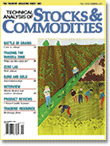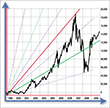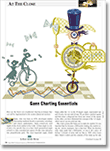Letters To The Editor
January 2011 Letters To The Editor
The editors of S&C invite readers to submit their opinions and information on subjects relating to technical analysis and this magazine. This column is our means of communication with our readers. Is there something you would like to know more (or less) about? Tell us about it. Without a source of new ideas and subjects coming from our readers, this magazine would not exist.
Address your correspondence to: Editor, Stocks & Commodities, 4757 California Ave. SW, Seattle, WA 98116-4499, or E-mail to editor@traders.com. All letters become the property of Technical Analysis, Inc. Letter-writers must include their full name and address for verification. Letters may be edited for length or clarity. The opinions expressed in this column do not necessarily represent those of the magazine. —Editor
SUSPECT TRENDS
 Editor,
Editor,
I just finished reading L.A. Little’s article “Price And Volume Disconnect” in the November 2010 issue of Stocks & Commodities. I have a general question I was hoping he could answer for me. (I loved the article, by the way.)
While I completely understand his reasoning behind identifying disconnects between price and volume as well as how to act when a suspect trend is spotted, I was hoping he could speak to why such situations sometimes arise in the first place. I know it’s a loaded question and I don’t expect a lengthy response, but I’m curious as to what might trigger a suspect trend. I would be happy to do further reading if he had any recommendations.
—Dave
L.A. Little replies:
Suspect trends are a natural occurrence, in my opinion. They are part of the natural ebb and flow of the market. In the current market environment, there is less overall interest in stocks as a result of the lingering worries about the future that are predicated on the 2008 financial debacle. Those concerns do not disappear quickly, and despite a rise in the market of tremendous percentages, the concern remains for a subsequent fall along the lines of 2000 and 2008.
That’s a big-picture explanation. On a more micro level, the ebb and flow could simply be an extended stock, or a general market where the larger buyers discontinue purchases because the stock or index has moved too far too fast. Volume decreases as a result of their absence, but price pushes higher because momentum remains and nobody wants to sell what they have or short sell the stock. In this way, price moves higher, volume decreases, and the process continues until the supply/demand equation changes — in other words, the price reaches such a level that additional sellers are willing to part with their shares and to do so more aggressively. That is when the tide finally turns and the retrace begins.
In general, the markets are dynamic and they are in an endless state of attempting to discover the correct price. My attempt to distinguish between suspect and confirmed trends is predicated upon the desire to understand the supply and demand balance at critical points on the chart and to provide a trader’s edge on the likelihood of a continuation or a reversal.
GANN METHODS
 Editor,
Editor,
I really enjoyed the series of articles on Gann techniques contributed by Koos van der Merwe over this past year in Stocks & Commodities. I would love to learn more about Gann’s methods. Could the author suggest some further reading?
—Gary
Koos van der Merwe replies:
A good book to start with is Gann Made Easy by William McLaren and Matthew J. Foreman (Traders Press).
GANN CHARTING ESSENTIALS
 Editor,
Editor,
As a stock and bond trader in the US markets, I found Koos van der Merwe’s article, “Gann Charting Essentials” (Stocks & Commodities, June 2010), really superb; a most useful brief of Gann’s work, which still applies today. I read a lot but can’t read everything, so a summary of books like this is always welcome. Does he have any other articles like this one?
—Andrew
Koos van der Merwe replies:
Thank you for the compliment. I write for Traders.com Advantage (an online publication by the same publisher as this magazine) weekly giving my market views and applying both Elliott wave and Gann analysis. I also submit articles as often as I can to this magazine, many of which you can read in past issues. I understand that the editor is considering publishing an update to my April 2010 article on Kondratieff waves.
Should you have any questions regarding the movement of the market, you are welcome to contact me.
Editor: For those interested, here is a list of recent articles by Koos van der Merwe in Stocks & Commodities:
“Trading Forex, Technically”
(January 2010)
“Kondratieff Wave Comeback”
(April 2010)
“Gann Charting Essentials”
(June 2010)
“Projecting Price And Time With Gann Fans And Angles”
(July 2010)
“Gann And The Time Factor”
(August 2010)
“Less Stress With The JM Internal Band”
(December 2010)
Here are some recent articles by Koos van der Merwe that appeared in our online publication, Traders.com Advantage:
“Are My Elliott Wave Counts Too Conservative? You Decide”
(11/18/10)
“What Now, Dow? Looking For Our Strategy”
(11/15/10)
“LivePerson Buy?”
(11/10/10)
“SNC-Lavalin Group”
(11/08/10)
“The Wave 4 Correction”
(11/04/10)
THINKORSWIM CODE?
Editor,
I really like your magazine. I’m wondering if there are plans to include Thinkorswim code as a regular supported platform?
—Rajeev
See also the next letter and reply.
—Editor
METATRADER 4 CODE?
Editor,
Do you ever publish MetaTrader 4 code in your Traders’ Tips section? I am interested in Ron Black’s Clear method described in your September 2010 issue.
—Cliff Dominy
Unfortunately, neither Thinkorswim nor MetaQuotes Software (developer of MetaTrader) are currently providing code for our Traders’ Tips section.
Sometimes, when our authors use a particular software platform, they will provide code for that platform with their articles.
—Editor
ERRATA: WINNING THE BATTLE OF THE GRAINS
Editor,
In your November 2010 issue, on page 18, Figures 3 & 4 refer to “short/short spreads” — I believe that should have read “long/short spread.”
—MP
Thank you for pointing out this error. It should have read, “short December corn/long December wheat spreads.”
—Editor
ERRATA: DECEMBER 2010 TRADERS’ TIPS
In our December 2010 Traders’ Tips section, we inadvertently left out the contribution from MetaStock. Readers will find the December 2010 Traders’ Tip for Meta�Stock on the topic of the Hull moving average at our website, www.Traders.com. We apologize for this omission.
To access the Traders’ Tips area at our website, use our site’s search engine, or visit the back issues archive.